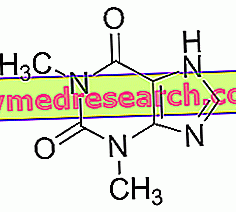Theophylline is a bronchodilator used in the treatment of bronchial asthma.

Theophylline - Chemical Structure
From a chemical point of view, theophylline is a natural methylxanthine found in the tea plant and - in smaller quantities - also in coffee and cocoa plants.
Examples of medicinal products containing theophylline
- Aminomal ® 0.67% oral solution.
- Theo-Dur ®.
- Theolair ®.
Indications
For what it uses
The use of theophylline is indicated for the treatment of:
- Bronchial asthma;
- Lung diseases accompanied by bronchospasm.
Warnings
Theophylline must be used very carefully in the following cases:
- In elderly patients;
- In patients with heart disease;
- In hypertensive patients;
- In patients suffering from severe hypoxemia;
- In patients with hyperthyroidism;
- In patients with congestive heart failure;
- In patients with chronic pulmonary heart;
- In patients with peptic ulcer;
- In patients suffering from liver and / or kidney diseases.
Theophylline should not be used in conjunction with other treatments of the same type.
Smoking can reduce the plasma concentration of theophylline and consequently reduce its therapeutic efficacy.
Alcohol, on the other hand, can increase the effects of theophylline, therefore, this association must be avoided.
Theophylline could worsen any pre-existing cardiac arrhythmias.
Interactions with other drugs
Concomitant administration of theophylline and the following drugs may increase the plasma concentration of theophylline itself, so great caution should be used:
- Lincomycin and clindamycin, antibiotic drugs belonging to the family of lincosamides;
- Cimetidine, a drug used to reduce acid secretion of the stomach;
- Allopurinol, a drug used for the treatment of gout;
- Propranolol (a drug used in the treatment of hypertension and angina pectoris) and other beta-blocker drugs;
- Ciprofloxacin, levofloxacin, ofloxacin, norfloxacin, enoxacin and other antibiotics belonging to the class of quinolones;
- Disulfiram, a drug used in the treatment of alcoholism;
- Oral contraceptives containing estrogens;
- Methotrexate, an anticancer;
- Recombinant human alpha interferon ;
- Verapamil, an antihypertensive;
- Ticlopidine, a platelet antiplatelet;
- Oral anticoagulants ;
- Fluvoxamine, an antidepressant belonging to the SSRI class;
- Influenza vaccine .
Phenytoin and other anticonvulsant drugs, on the other hand, can decrease the plasma concentration of theophylline, thereby reducing its therapeutic efficacy.
The concomitant intake of theophylline and St. John's wort (or St. John's wort, a plant with antidepressant activity) may cause a decrease in the plasma concentration of theophylline itself. Therefore, in patients taking both this medication and hypericum preparations, regular checks are necessary to determine the blood levels of theophylline.
Concurrent administration of theophylline and reserpine may promote the onset of tachycardia.
Concomitant use of theophylline and pentoxifylline increases the risk of seizures.
In any case, it is a good idea to inform your doctor if you are taking - or have recently been - any type of medication, including non-prescription medicines and herbal and homeopathic products.
Side effects
Theophylline can cause various types of side effects, although not all patients experience them.
This depends on the different sensitivity that each individual has towards the drug; therefore, it is not said that the adverse effects occur all with the same intensity in each person.
The main side effects that may occur during theophylline treatment are listed below.
Nervous system disorders
Theophylline therapy may cause:
- Headache;
- Hyperreflexia (ie the accentuation of reflexes);
- Convulsions.
Psychiatric disorders
During theophylline treatment can occur:
- Restlessness;
- Irritability;
- Insomnia.
Cardiovascular disorders
Theophylline therapy can cause the onset of:
- Hot flashes;
- Hypotension;
- Palpitations;
- Tachycardia;
- extrasystoles;
- Circulatory insufficiency (shock);
- Severe ventricular arrhythmias.
Gastrointestinal disorders
Theophylline treatment can cause:
- Nausea;
- He retched;
- Hematemesis, that is the presence of blood in vomit;
- Diarrhea;
- Epigastric pain.
Kidney and urinary tract disorders
Theophylline treatment can cause:
- Albuminuria, ie the increased concentration of albumin in the urine;
- Polyuria (ie increase in the amount of excreted urine);
- Presence of tubular cells in the urine;
- Increased amount of red blood cells in urine.
Other side effects
Other side effects that may occur during theophylline therapy are:
- Hyperglycemia;
- Muscle cramps;
- Increased respiratory rate (tachypnea).
Overdose
In case of excessive doses of theophylline, the first symptoms that arise are:
- Tremors;
- agitation;
- Confusion;
- He retched
- Tachycardia.
Then appear:
- Hematemesis;
- Cardiac arrhythmias;
- Dehydration;
- Temperature.
In case of overdosage it could be useful to induce vomiting or perform gastric lavage.
In any case, if you suspect a theophylline overdose, you must contact your doctor immediately and contact the nearest hospital immediately.
Action mechanism
As mentioned, theophylline is able to exert a bronchodilator type action. In fact, the exact mechanism by which this drug performs its action has not yet been fully clarified and several possible mechanisms of action have been proposed.
First of all, it appears that theophylline is able to inhibit particular enzymes called phosphodiesterases (PDEs) that are involved in bronchoconstriction.
Theophylline, however, is also an antagonist of the adenosine receptors and this means that there is a reduced histamine release, with a consequent reduction in bronchoconstriction.
Finally, theophylline is also able to stimulate the release of catecholamines and also this mechanism could be able to favor bronchodilation.
Mode of Use - Posology
Theophylline is available for oral administration in the form of prolonged-release tablets, in the form of prolonged-release hard capsules or in the form of oral suspension.
Theophylline has a narrow therapeutic index, therefore - to avoid the occurrence of dangerous side effects - during treatment with the drug it is essential to follow scrupulously the indications provided by the doctor, both as regards the amount of theophylline to be used, and for how much it concerns the frequency of administration and the duration of the same therapy.
Generally, the usual drug dose for adults varies from 200 to 350 mg, to be taken twice a day.
In children, on the other hand, the dose of theophylline usually used ranges from 100 to 200 mg, twice a day.
In any case, as mentioned, it is essential to follow exactly the instructions given by the doctor.
Pregnancy and breastfeeding
Theophylline should be used by pregnant women only if the doctor considers it absolutely necessary.
The use of theophylline by breastfeeding mothers, on the other hand, is contraindicated.
In any case, pregnant women and breastfeeding mothers must always seek medical advice before taking any type of medication.
Contraindications
The use of theophylline is contraindicated in the following cases:
- In patients with known hypersensitivity to the same theophylline;
- In patients with known hypersensitivity to other xanthine derivatives;
- In patients with acute myocardial infarction;
- In patients in hypotensive states;
- During breastfeeding.



